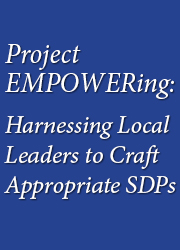
Proven often enough, addressing a societal problem is not a one-man show or something that happens overnight. It requires an appropriate and systematic development approach and collective effort from different stakeholders, namely, the local government at the front line, the academe to conduct studies, the private sector for funding support and, of course, the communities themselves.
In Misamis Oriental, a partnership was forged last September 2011 to fill in the gaps and needs of the local government units (LGUs) in the planning, implementation and monitoring capabilities of their social development programs (SDPs).
Public-Private Partnership
Xavier University, through its Research and Social Outreach (XU-RSO) spearheaded a public-private collaboration, together with STEAG State Power Inc., German Development Agency Deutsche Investitions- und Entwicklungsgesellschaft (DEG), Asia Society for Social Improvement and Sustainable Transformation (ASSIST Asia), a non-government organization (NGO), Department of Interior and Local Government Region 10 (DILG-10), the municipal governments of Jasaan, Laguindingan, Medina, Opol and Tagoloan and the city governments of El Salvador and Cagayan de Oro.
Project EMPOWERing (Enhanced Monitoring System on Poverty Watch for More Effective and Responsive Approach in Governance) was crafted for greater societal engagement among the stakeholders. This program is an offshoot of the Local Poverty Reduction Action Planning (LPRAP) undertaken by the Municipality of Villanueva in partnership with various public and private institutions.
“The goal of this project is to help the community using an evidence-based approach,” says Dr Hilly Roa-Quaoit, Vice President of XU-RSO in the efforts to better equip the LGUs in their poverty reduction measures.
Project EMPOWERing utilizes poverty diagnosis tools such as the Community-Based Monitoring System and Geographic Information System (CBMS-GIS) in the five areas—Environment, Food Security, Health and Sanitation, Peace and Order and Governance.
Results Presentation
The results of the study were presented to the different stakeholders at The Grand Caprice, Lim Ket Kai Center on March 20, 2013.
Lita Sealza, CBMS Project Coordinator, presented the findings on the four LGUs (El Salvador, Jasaan, Medina and Opol) in terms of the various facets of poverty (five areas) using the CBMS Poverty Indicators and the Millennium Development Goals (MDGs) Indicators.
The results, which were laid out in graphs and tables, were revealing of the things and areas where greater attention and collaborative actions are needed.
On the other hand, the mayors of the four aforementioned municipalities accepted the challenge of improving the quality of life of their constituents. One goal of this CBMS-GIS Integration Project is to guide the LGU leaders in the proper channeling of their resources and social development programs.
After almost two years, the project will officially close this June. Dr Dixon Yasay, Director of XU Governance and Leadership Institute (XU-GLI) says that the real challenge for the local leaders is “the ownership of the information and to utilize the results of the CBMS study.”
“The academe can only provide the expertise and the evidence,” he said. “The information will not be useful unless it is used.”
- Stephen Pedroza